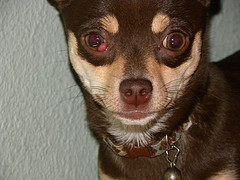You hear people talking your dog’s third eyelid, but what do you really know about? Like, why do they even have one? Since it is part of your dog that can cause some health issues, it’s good to know what it is, what problems it can cause, and what to look for.
Dr. Yasmine Mortsakis, DVM and Director of the Health & Wellness at NY Vet Practice, which offers full-service veterinary care to Biscuits & Bath, answered our questions on this important topic.
What Is it?
The nictitating membrane, haw, or “third eyelid,” as it is called, closes across the eye (unlike the upper and lower eyelids) and are there as extra protection for that all important eye.
Removal is not recommended as it has a function. The third eyelid serves a few functions:
- It protects the eye the way the other eyelids do and can wipe debris off the surface of the eye
- It has a gland that produces 1/3 of tears for the eye
- It has some limpid tissue in the glad that helps fight off infection
Are there problems it can cause? Are these Breed specific?
The third eyelid has a gland that can prolapse or “pop” out and become visible. This is congenital and breed specific: beagles, Boston terriers, bull dogs, and cocker spaniels are the main sufferers. When it protrudes it can cause irritation to the cornea (surface of the eye).
Are there things owners should watch for?
Some dogs can be born with the third eyelid visible. Other than those cases if the is eyelid becomes visible it is a sign that something is wrong with the eye. Trauma to the eye can cause the eyelid to be visible as can a prolapsed gland of the third eyelid (mentioned above).
Any preventative care?
No real preventative care other than keeping eyes clean and free of debris and hair and regular veterinary exams.

Can you talk a bit about Cherry Eye: what it is, why some dog breeds are more prone to it than others?
There is a tear gland around the cartilage of the third eyelid that produces about 1/3 of tears for the eye. In a dog with cherry eye, the fibrous attachments of the gland to of the third eyelid are weak or strained. This allows the gland to prolapse, or bulge out from beneath the eyelid. It looks red or pink and is commonly called cherry eye. This can irritate the surface of the eye and produce recurrent conjunctivitis. There is surgery to replace the gland back into position. if not replaced, the gland can stop producing tears and can result in dry eye condition
It is a hereditary defect; one thought is that some breeds have less physical space in the eye orbit for the gland.
About the Author
Based in Wilsonville, Ore., animal lover Kristina N. Lotz is a Certified Professional Dog Trainer – Knowledge Assessed (CPDT-KA) and works as a full time trainer. She also owns her own custom pet products company, A Fairytail House, where she makes personalized collars, leashes, beds, keepsake pillows and blankets, and anything else your imagine can think up. In her spare time, she trains and competes in herding, agility, obedience, rally, and conformation with her Shetland Sheepdogs. She smartly married a Veterinary Technician, who helps keep the fur kids happy and healthy, and provides a quick resource for articles.
